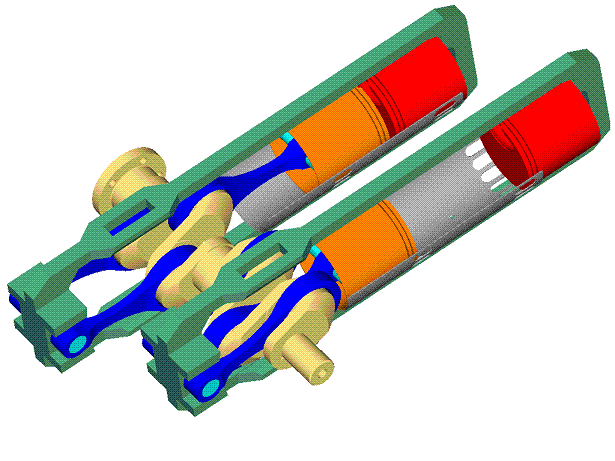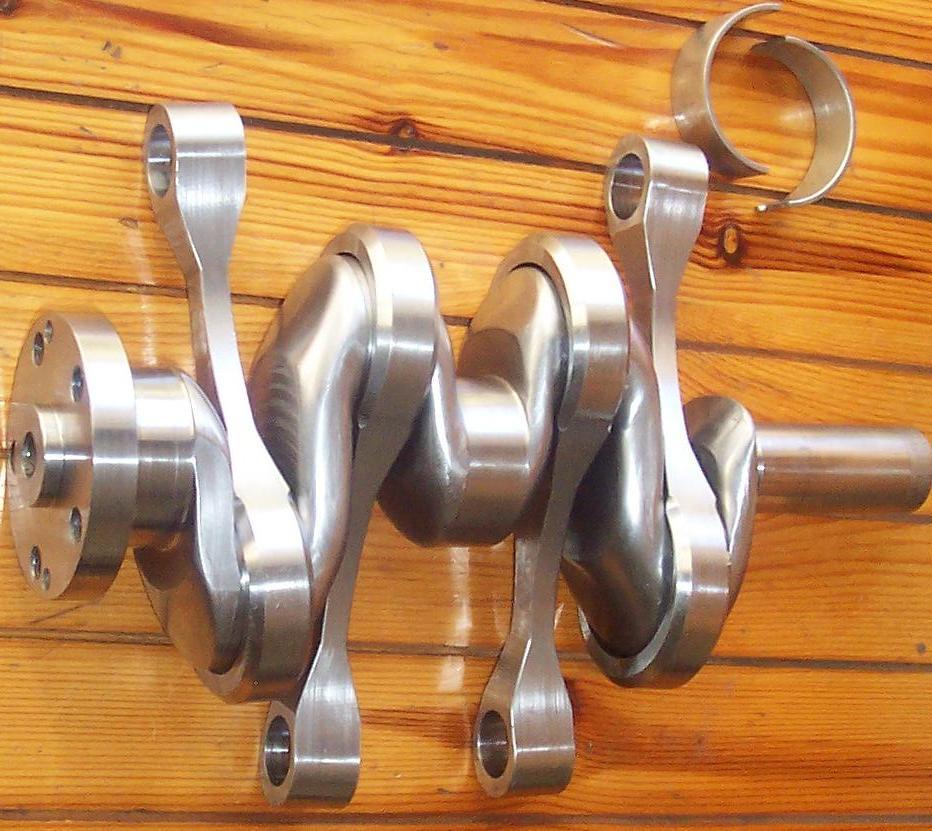Hello all.
Marc Jackson (Muniix) wrote:
“Which has a huge amount of ring friction area, 3 ring packs with 1 huge bore.
It has reduced turbulence at start of combustion due to reduced piston velocity towards TDC compared to mean piston velocity. This slows combustion significantly requiring the engine to run at higher speeds and greater losses consuming more fuel less effiently.
Slower combustion causes higher heat loss, Lower thermodynamic efficiency.
All those large big end bearings have clearly not been through any size or friction optimisation, the bigend larger than the mains, insane more excessive friction and masses increasing inertial forces combined with its need to run at higher speeds this is terrible design.
Rating. 0 out of 5, fail, try again”
Here is the “new model” of Achates Power (actually a replica of the Junkers Jumo 205).

The external scavenging pump (top right, driven by the upper crankshaft though a pair of pulleys and a belt) provides compressed air – through the two “silver tubes” – to the front and back sides of the cylinder block.
The cost of such a scavenging pump is comparable, if not higher, than the complete cost of a similar capacity PatOP having integral piston-type scavenge pump.
The efficiency of a supercharger / blower cannot compare with a “piston type” scavenge pump, especially when the last is integrated in a combustion piston of a 2-stroke.
The structure of the PatOP (pulling rods, wrist pins at the opposite – cold - side of the crankshaft relative to the “combustion piston crown” etc) enables the integration, without increasing the number of parts used, of a scavenging pump.
The additional cost: a set of piston rings!
Several marine 2-stroke engines (those with the near 50% brake thermal efficiency) had “piston type” scavenge pumps.
Hugo Junkers (who designed and manufactured the Jumo 205 and several other Opposed Piston engines for airplanes), also designed / patented the famous Junkers-Doxford single-crankshaft opposed-piston engine (it was manufactured, under the license of Junkers, in Great Britain by Doxford and it was the typical marine engine till the 2nd world war):

Do take a look at the
http://www.shipsnostalgia.com/guides/Wi ... d_and_Sons web site:



The Junkers-Doxford uses a piston-type scavenge pump:

wherein the scavenge pump piston is driven by its own crankpin and connecting rod.
This is a significant complication and cost: a crankpin dedicated to the scavenging, a pair of additional main crankshaft bearings, a couple of meters longer engine.
(by the way: think how much shorter – and more robust – the Junkers-Doxford would be based on the architecture of the pattakon PatPOC engine:

more at:
http://www.pattakon.com/pattakonPatPOC.htm )
In the PatOP things are different and more efficient than in the old marine engines with the piston-type scavenge pumps:
the big piston of the scavenge pump is secured on the “free” backside of the “inner” combustion piston of the PatOP (which means: it is driven directly, without adding connecting rods or crankpins etc).
With the big diameter scavenge piston at its backside, the “inner piston assembly” of the PatOP gets as heavy as the “outer piston” assembly (that with the two “barrel cross-heads).
The crankshaft needs not balance webs, at all, which, among other, allows single piece crankshaft and connecting rods to be used:

No external balance shafts are required.
The PatOP, even in the single cylinder version, is an engine which, without any balance web, is fully balanced.
Slower piston at the combustion dead center and combustion efficiency:
Even with the best fuel, the power of a compression ignition engine drops steeply after, say, 4,500 rpm.
This is because the fuel needs time (absolute time, in milliseconds) to get prepared before the combustion.
What the PatOP and the OPRE (i.e. the pulling connecting rod architecture) offer?
Time. Absolute time:

At 6,000rpm pistons of the PatOP remain in the last 15% of their stroke

for more than 30% than the piston of a conventional running at the same revs.
With the same BMEP (brake mean effective pressure) the compression ignition engine can make some 30% higher power, because the PatOP can burn its diesel fuel efficiently (in time) at 30% higher revs.
From another point of view: at the same revs with a conventional, the PatOP has 30% more time that gives the chance for the optimization of the injection of the fuel.
This plot :

shows that during most of the compression and the expansion, the piston of the PatOP moves, more or less, as fast as the piston of the conventional, and that during the end part of the piston stroke the piston of the PatOP “stops” and gives time to the combustion.
With the additional time provided by the pulling rod architecture, the designer has more options: at low revs the fuel can be injected substantially later (in crank degrees), while at high revs the fuel can be injected earlier (again in crank degrees) because at the same angle before the TDC the “compression” in the PatOP is substantially higher.
From another point of view: you have a conventional Diesel wherein the power output at 6,000rpm falls by 50% as compared to the power output of the same engine at 4,500rpm (despite the fact that at 6,000rpm the injected fuel is some 33% more).
What happens?
The fuel needs time to be prepared and burnt.
The time provided at 6,000rpm is not adequate.
The injection should start substantially earlier, but then the pressure and temperature would not be adequately high. Inevitably most of the fuel burns (if it is burnt) at substantially low expansion ratios (like, say, 5:1 or lower) which causes the steep drop of the power and the steep increase of the BSFC.
In comparison, a PatOP diesel revving at 6,000rpm is, for the fuel (note: the fuel gets into the cylinder only at the end of the compression), like a conventional running 4,500rpm. There is time for efficient combustion. The engine makes some 30% more power than the conventional and the BTE is similarly high with the conventional revving at 4,500rpm.
Accordingly, the additional dwell of the PatOP is not a constrain / restriction, it is an option.
The main crankshaft bearings of the PatOP run actually unloaded (this is a characteristic of other single cranksahft Opposed Piston engines, too, like the Junkers-Doxford and the OPOC), while the bearings at the big ends of the connecting rods of the PatOP are heavily loaded (combustion loads, inertia loads).
It is more than simple. However it still sounds complex, please let me know to further explain.
According all the previous “simple-minded” analysis:
The unique characteristics of the PatOP engine make it better than the state-of-the-art Opposed Piston engines.
It is sad that EcoMotors (of Bille Gates et al) is (?) closed.
And it is pity that Achates Power struggles with wrong basic designs (either that with the side crankshafts and the long (like bridges) connecting rods, or with the replica of the Junkers Jumo) while they have the funds, the machinery, the staff etc to put the Opposed Piston 2-strokes in production..
Thanks
Manolis Pattakos










